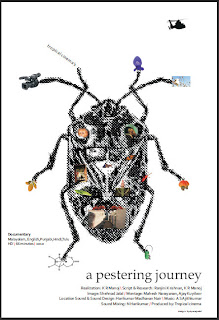A Pestering Journey

- Documentary/66 minutes/2010/English,Malayalam,Tulu, Hindi, Punjabi
Director K R Manoj's well-paced journey through the remnants of two Pesticide tragedies in India leaves the viewers with distrubing images of the long term effects of using harmful chemicals for farming. In addition, it also provides the people with a new found energy to fight for their earth.The documentary, which will be screened outside the 2011 Geneva convention in Stockholm (Conference Of Parties), is an invaluable asset to the Indian environmentalists who are fighting the indian politicians in an effort to enforce a global ban on harmful pesticides like endosulfan.
The movie first explores the "Cancer Train"- A train whose majority of passengers are patients who travel back and forth from Bhatinda to Bikaner for their cancer treatments. As a part of Green Revolution, a large amount of chemical pesticides were used in the southern Punjab in its cotton belt. Over a period of time, continuous exposure of these chemicals led to various health issues among the day labourers and the nearby villagers, the killer among them being Cancer. Its shocking to know that on certain days, the Cancer train has 90% of its passengers going to the cancer hospital in Bikaner. The movie does not make the viewer sit through disturbing images and video footages but takes a subtle approach which makes the effect of the movie more pronounced and the disturbance lingers long after the show is over.The viewers are left with probing questions - were all these problems due to green revolution or the way in which it was implemented .Whether the revolution was worth all these? Or was it the idea that was embedded in the minds of farmers all over india that these "medicines" are a must for plants to grow well?
Another similar and more dangerous case is then ventured upon- The endosulfan tragedy in Kasaragod district of Kerala. Years of exposure to aerial spray of the chemical used as a pest killer for Cashew plants had totally disturbed the balance of earth in the locality: contaminated waterbodies, dead birds and other living organisms, skin rashes, children born with genetic defects and much more.Certain visuals like the girl in the wheelchair and the mother protesting against continous humiliation and useless fights brings a lump in your throat. Due to the constant effort of few environmentalists and locals, the court has banned the aerial spray of endosulfan in these areas. It was heartening to know that things are getting normal in these areas - crows and peacocks are back, no more birth defects in children and cleaner water. However the original victims are still suffering and they still need our support for their treatment and daily errands. As responsible citizens, its our responsbility to fight for the ban of all these dangerous pesticides and move towards promoting organic ways of cultivation.The documentary also examines the business aspect of the endosulfan deal which is preventing our political leaders from voting for the global ban of endosulfan.
The creators of these documentary - Manoj and Ranjini - have taken a philosophical path in attacking these issues - Who the real pest is and how the terms "pesticide"and"genocide" are so inter-related! The camera crew and the sound engineers have done an amazing job to give the documentary its desired effect. Overall this movie will serve as an asset for all the fights against the use of harmful pesticides in our country. And let me wish Manoj and Ranjini the very best and well wishes for the success of their hardwork and hope that you will create more of such gems in the future.



Comments